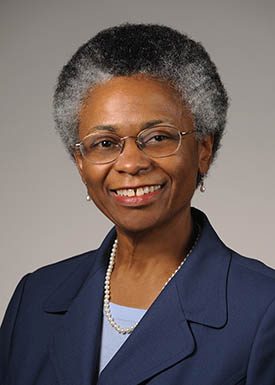New Chief Officer for Scientific Workforce Diversity
Marie Bernard Is Helping to Make Change Happen
“We’re at a tipping point,” said Marie Bernard, NIH’s new Chief Officer for Scientific Workforce Diversity (COSWD). She is leading NIH’s efforts to diversify the national scientific workforce and expand recruitment and retention. NIH has long recognized that teams made up of people from diverse backgrounds and experiences are better than homogenous teams at fostering innovative science and are more likely to engage in research that will benefit underserved populations. But change isn’t happening fast enough. “Disparities seen in COVID deaths,” among other disturbing events across the country, have inspired NIH to redouble its efforts. “Everyone is really focused,” said Bernard, who has met with almost every institute and center (IC) director and is beginning systematic meetings with scientific directors as well.

Marie Bernard
“Dr. Bernard is an accomplished physician-scientist and has championed diversity and inclusion efforts over her entire career,” said NIH Director Francis Collins in a news release announcing her appointment as COSWD in May 2021. “Her dedication and passion in creating equity and inclusion throughout the biomedical research enterprise are profound and inspiring.”
Bernard, who was deputy director of the National Institute on Aging (2008–2021), has held key leadership roles—and has received many awards for her work—in a variety of NIH and national activities that are furthering diversity. She serves as a co-chair of NIH’s UNITE initiative, an effort to identify and address structural racism within the NIH-supported and the greater scientific community. UNITE aims to establish an equitable and civil culture and reduce barriers to racial equity within the biomedical research workforce.
Since becoming acting COSWD in October 2020, she has been building on the strong foundation set by Hannah A. Valantine, NIH’s first-ever COSWD, who retired last year. Bernard heads the Office of Scientific Workforce Diversity (OSWD), which is striving to stimulate diversity inside as well as outside NIH. For the intramural research program, the OSWD is helping ICs recruit diverse candidates into senior-level scientist positions including as scientific directors. Bernard also hopes to bring more senior tenured scientists to the Distinguished Scholars Program, which facilitates the hiring and career progression of tenure-track investigators who have demonstrated a commitment to promoting diversity and inclusion in the biomedical-research enterprise.
“There’s no silver bullet” to make these changes happen, Bernard explained. “Sometimes change can be scary but we’ll all be working together.”
For example, “we think there are opportunities to think about people from diverse backgrounds for standard lectures [and positions on Boards of Scientific Counselors as regular or ad hoc members,” she said. “Our office has a role to play in helping scientific directors and others better identify potential candidates with diverse backgrounds.”
Prior to joining NIH in 2008, Bernard was the endowed professor and founding chair of the Donald W. Reynolds Department of Geriatric Medicine at the University of Oklahoma College of Medicine (Oklahoma City) and Associate Chief of Staff for Geriatrics and Extended Care at the Oklahoma City Veterans Affairs Medical Center.
She received her M.D. from the University of Pennsylvania (Philadelphia) and trained in internal medicine—and was chief resident—at Temple University Hospital (Philadelphia). She received additional training through the Association of American Medical Colleges Health Services Research Institute, the Geriatric Education Center of Pennsylvania, and the Wharton School Executive Development program.
Bernard’s research at the University of Oklahoma focused on nutrition and function in older populations, specifically underrepresented minorities. At NIH, she led a NIH-wide portfolio analysis—on inclusion of older adults in clinical trials—that contributed to NIH’s updating its inclusion policies. Prior to the 21st Century Cures Act, NIH had policies in place mandating the inclusion of women, underrepresented minorities, and children in clinical studies. Bernard’s analysis demonstrated that the average age of older adults included in NIH-funded phase 3 clinical trials for common problems of older adults was younger than expected given the age distribution in the general population. This contributed to NIH’s response to the 21st Century Act’s requirement that NIH reexamine its age inclusion. In 2019, NIH updated its child inclusion policy to “ Inclusion Across the Lifespan,” requiring inclusion of children and older adults. “We’re pretty proud to have contributed to that,” said Bernard. (J Am Geriatr Soc 67:218–222, 2019; DOI:10.1111/jgs.15786)
Bernard notes that she is excited to serve as the new COSWD and co-chair the NIH UNITE initiative, fully focusing on enhancing diversity of the scientific workforce and building upon the great momentum currently at NIH. “We have to do the work now to make things happen,” said Bernard. “People seem to be committed to doing exactly that. We will have to continue to push ourselves, measure ourselves, and be transparent and accountable as well.”
This page was last updated on Thursday, February 3, 2022
